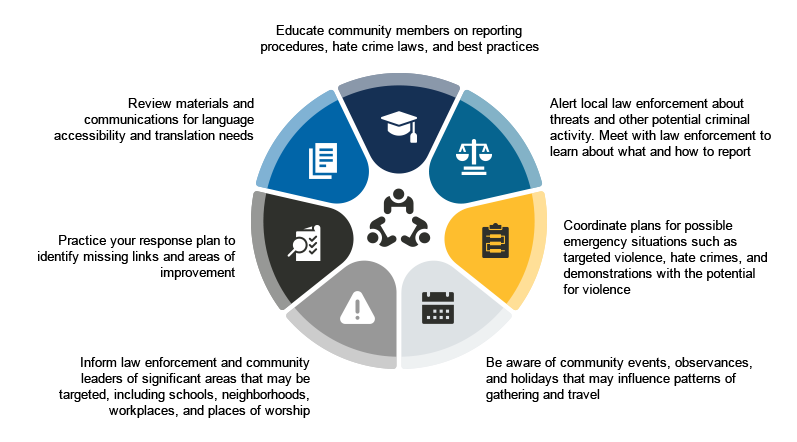Preventing and Responding to Bias and Hate Incidents in K-12 Educational Settings: A Toolkit for School & Community Leaders
Everyone deserves safe and inclusive learning environments free of harassment and discrimination. Well-designed and facilitated opportunities for groups to dialogue can enable communities to address differences, through respectful sharing of perspectives that move toward solutions focused on the common good.
Best practices for difficult conversations
- Redesign meeting formats to include smaller meetings or breakout sessions
- Provide multiple opportunities for community members to dialogue together
- Develop ground rules that emphasize civil and respectful discourse, designate positions with clear roles (facilitator, timekeeper, etc.), and announce specific meeting topics and purpose
- Use experienced facilitators who can defuse tensions, reframe issues, and help participants discuss solutions
- Use co-facilitators for large groups or break out groups to address the needs of all participants
- Recognize that groups may not be ready to collaborate on solutions if they don’t feel that they have been heard
- Create a process for community groups to collaborate on solutions
- Ask CRS for meeting design, facilitation support, or training on Facilitating Meetings Around Community Conflict
Host a public solidarity event against hate and bias
Where appropriate and safe, public events and virtual convenings can be used to raise awareness on bias and hate impacting communities.
- Host a community forum, facilitated dialogue, listening session, or email tip box related to bias and hate for survivors, supporters, and allies to express their concerns
- Share existing information and resources on bias and hate such as local commissions, programs, and community-based organizations
- Invite other stakeholders such as faith leaders, community leaders, and law enforcement
Be prepared for possible unrest, bias incidents, and hate crimes
Identify and prepare for events where there may be an increased potential for hate or bias incidents.
- Educate community members on reporting procedures, hate crime laws, and best practices
- Alert local law enforcement about threats and other potential criminal activity. Meet with law enforcement to learn about what and how to report
- Coordinate plans for possible emergency situations such as targeted violence, hate crimes, and demonstrations with the potential for violence
- Be aware of community events, observances, and holidays that may influence patterns of gathering and travel
- Review materials and communications for language accessibility and translation needs
- Practice your response plan to identify missing links and areas of improvement
- Inform law enforcement and community leaders of significant areas that may be targeted, including schools, neighborhoods, workplaces, and places of worship
Reduce the toll that bias and hate can have on the mental and physical well-being of impacted groups
- Have your working group engage with experts to ensure a common understanding of when and how mental health resources may be used
- Provide mental health resources to survivors and members of communities experiencing bias and hate
- Familiarize your working group with local law enforcement processes for working with suspects with mental health issues
- Ensure response personnel have access to mental health and trauma support
- Ensure survivor and witness resources are culturally appropriate
Equip schools to respond to bias and hate incidents
- Encourage your school to have a cyberbullying and harassment policy
- Train school officials on bias and hate incident reporting and investigation procedures
- Reach out to impacted students
DOJ Resources
|
Community Relations Service Event Marshals: Maintaining Safety During Public Events (PDF) Event Marshals Tipsheet (PDF) Facilitator Training, "Facilitating Meetings Around Community Conflict" (PDF) CRS Services for School Communities Helping Communities Prevent and Respond to Hate Crimes (PDF)
Federal Bureau of Investigation Hate Crimes Threat Guide (PDF) |
Community Oriented Policing Services Stop Hate & Build Inclusion: Resources for Law Enforcement and Community Partners Hate Crime Reporting—Working to Close the Gap Improving the Identification and Reporting of Hate Crimes Stop Hate: Action Steps for Local Communities
Civil Rights Division, Educational Opportunities Section
Educational Opportunities Section Homepage Educational Opportunities Section Guidance and Resources Educational Opportunities Section Combating Improper Seclusion in Schools |
More Information
Toolkit: Preventing and Responding to Bias and Hate Incidents in K-12 Education Settings (PDF)

 U.S. Department
of Justice
U.S. Department
of Justice






